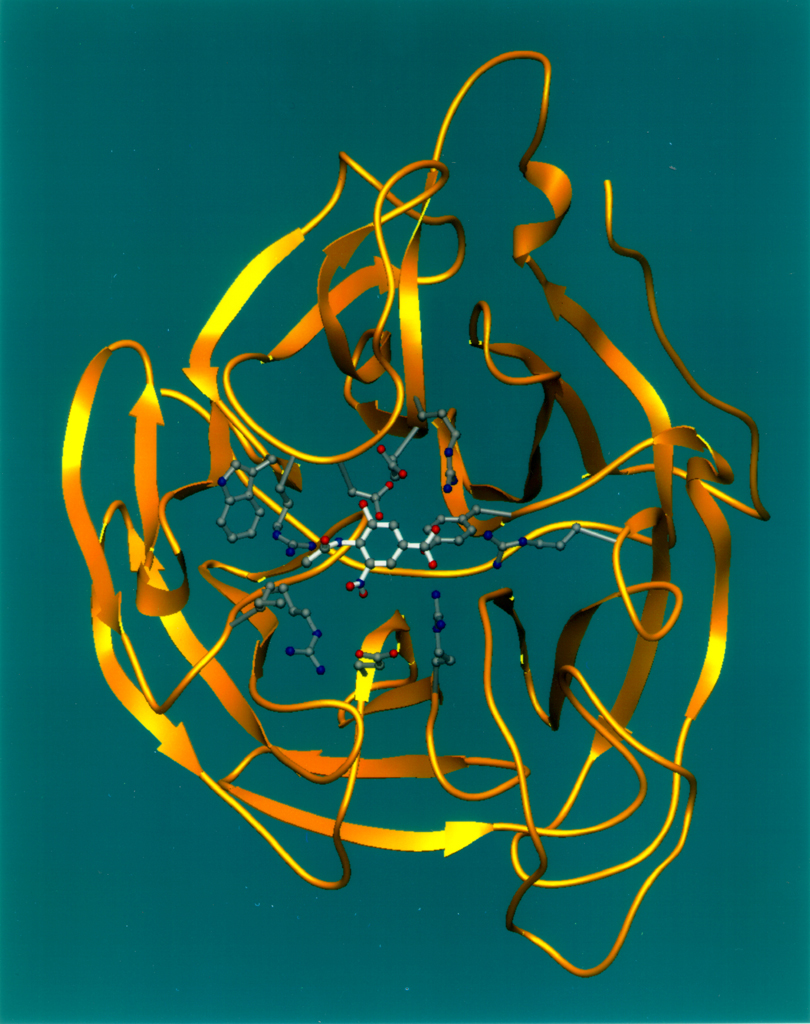Neuraminidase
| sialidase 1 (lysosomal sialidase) | |
|---|---|
 ribbon diagram | |
| Identifiers | |
| Symbol | NEU1 |
| Alt. symbols | NEU |
| Entrez | 4758 |
| HUGO | 7758 |
| OMIM | 608272 |
| RefSeq | NM_000434 |
| UniProt | Q99519 |
| Other data | |
| EC number | 3.2.1.18 |
| Locus | Chr. 6 p21 |
Neuraminidase is a glycoside hydrolase enzyme (EC 3.2.1.18). It is frequently found as an antigenic glycoprotein and is best known as one of the enzymes found on the surface of the Influenza virus. Some variants of the influenza neuraminidase confer more virulence to the virus than others. At least four neuraminidases in the human genome have been described. Deficiencies in the human enzyme NEU1 leads to the rare lysosomal storage disease sialidosis.
Subtypes
Swiss-Prot lists 137 types of neuraminidase from various species as of October 18, 2006.[1] Nine subtypes of influenza neuraminidase are known; many occur only in various species of duck and chicken. Subtypes N1 and N2 have been positively linked to epidemics in man, and strains with N3 or N7 subtypes have been identified in a number of isolated deaths[citation needed].
Structure
Influenza neuraminidase exists as a mushroom-shape projection on the surface of the influenza virus. It has a head consisting of four co-planar and roughly spherical subunits, and a hydrophobic region that is embedded within the interior of the virus' membrane. It comprises a single polypeptide chain that is oriented in the opposite direction to the hemagglutinin antigen. The composition of the polypeptide is a single chain of six conserved polar amino acids, followed by hydrophilic, variable amino acids.
Function
Neuraminidase has functions that aid in the efficiency of virus release from cells. Neuraminidase cleaves terminal sialic acid residues from carbohydrate moieties on the surfaces of infected cells. This promotes the release of progeny viruses from infected cells. Neuraminidase also cleaves sialic acid residues from viral proteins, preventing aggregation of viruses. Administration of chemical inhibitors of neuraminidase is a treatment that limits the severity and spread of viral infections.
Neuraminidase is also a virulence factor for many bacteria including Bacteroides fragilis and Pseudomonas aeruginosa, where it is produced to cleave a sialic acid residue off ganglioside-GM1 (a modulator of cell surface and receptor activity) turning it into asialo-GM1 to which its type 4 pilli (attachment factors) bind preferentially.
Ideally influenza virus neuraminidase (NA) should act on the same type of virus receptor the virus Hemagglutinin (HA) binds to. This is not always so. It is not quite clear how the virus manages to function if there is no close match between the specificities of NA and HA.
Neuraminidase also plays a role in the beginning of influenza pathogenesis by cleaving sialic acid from the host glycoprotein and allowing the virus to enter the host (T-phages, macrophages, etc.).
Neuraminidase inhibitors
Neuraminidase inhibitors are useful for combating influenza infection: zanamivir, administered by inhalation; oseltamivir, administered orally; and under research is peramivir administered parenterally, that is through intravenous or intramuscular injection.
See also
References
External links
- Neuraminidase at the US National Library of Medicine Medical Subject Headings (MeSH)
cs:Neuraminidáza de:Neuraminidase hr:Neuraminidaza it:Endo-alfa-sialidasi nl:Neuraminidase Template:WikiDoc Sources